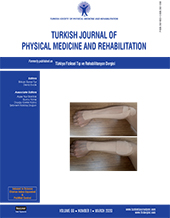Effects of robot-assisted gait training on lower extremity strength, functional independence, and walking function in men with incomplete traumatic spinal cord injury
2 Department of Emergency Medicine, Çanakkale State Hospital, Çanakkale, Turkey DOI : 10.5606/tftrd.2020.3316 Objectives: The aim of this study was to investigate the effects of robotic treadmill training on lower extremity motor function, functional independence, and walking in men with traumatic incomplete spinal cord injury (SCI).
Patients and methods: A total of 30 consecutive male patients (mean age 36.6 years; range, 19 to 53 years) with traumatic incomplete SCI who were admitted to our inpatient clinic of the rehabilitation hospital were included in this study. All patients had conventional rehabilitation for five days weekly. The patients were randomized into two groups as the robot-assisted gait training (RAGT) group (n=15) for 30 min for three times a week for a total of five weeks and the conventional rehabilitation group (control group, n=15). The patients were evaluated sociodemographically and neurologically at baseline. Lower Extremity Motor Score (LEMS), Spinal Cord Independence Measurement-III (SCIM-III), and Walking Index for Spinal Cord Injury-II (WISCI-II) were used at baseline, at the end of the fifth week, and at three months after the treatment.
Results: The mean disease duration was 23±33 months in the RAGT group and 28.6±17 months in the conventional rehabilitation group (p>0.05). A significant improvement was observed in the LEMS, WISCI-II, and SCIM-III scores after the treatment in both groups (p<0.05). The improvement in the LEMS scores was significantly higher in the RAGT group at the end of the fifth week and at three months (p=0.017). The SCIM-III scores were also significantly improved in the RAGT group at the end of the fifth week and at three months (p=0.038).
Conclusion: Our study results show that conventional rehabilitation is useful in terms of the improvement in the lower extremity motor function, walking, and functional status in men with incomplete SCI. Additional RAGT provides a better improvement in the lower extremity motor function and functional independence.
Keywords : Functional status, robot-assisted gait training, Spinal Cord Independence Measurement-III, spinal cord injury, walking

















